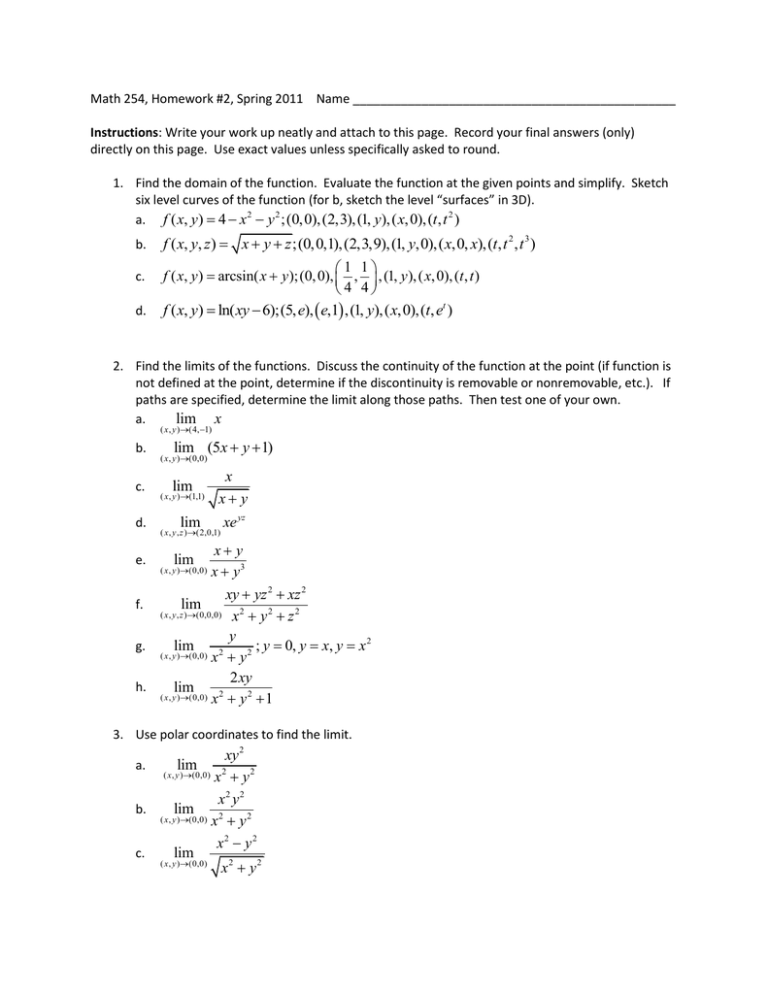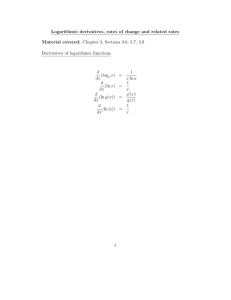Homework - BetsyMcCall.net
advertisement

Math 254, Homework #2, Spring 2011 Name _______________________________________________ Instructions: Write your work up neatly and attach to this page. Record your final answers (only) directly on this page. Use exact values unless specifically asked to round. 1. Find the domain of the function. Evaluate the function at the given points and simplify. Sketch six level curves of the function (for b, sketch the level “surfaces” in 3D). a. f ( x, y) 4 x 2 y 2 ;(0,0),(2,3),(1, y),( x,0),(t , t 2 ) b. c. d. f ( x, y, z) x y z ;(0,0,1),(2,3,9),(1, y,0),( x,0, x),(t, t 2 , t 3 ) 1 1 f ( x, y ) arcsin( x y );(0, 0), , , (1, y), ( x, 0), (t , t ) 4 4 f ( x, y) ln( xy 6);(5, e), e,1 ,(1, y),( x,0),(t, et ) 2. Find the limits of the functions. Discuss the continuity of the function at the point (if function is not defined at the point, determine if the discontinuity is removable or nonremovable, etc.). If paths are specified, determine the limit along those paths. Then test one of your own. a. lim x ( x , y ) (4, 1) b. c. d. e. lim (5x y 1) ( x , y )(0,0) lim ( x , y ) (1,1) lim x x y ( x , y , z ) (2,0,1) xe yz x y ( x , y ) (0,0) x y 3 lim xy yz 2 xz 2 ( x , y , z ) (0,0,0) x 2 y 2 z 2 y g. lim ; y 0, y x, y x 2 2 ( x , y ) (0,0) x y 2 2 xy h. lim 2 ( x , y ) (0,0) x y 2 1 f. lim 3. Use polar coordinates to find the limit. xy 2 ( x , y ) (0,0) x 2 y 2 x2 y 2 b. lim ( x , y ) (0,0) x 2 y 2 x2 y 2 lim c. ( x , y ) (0,0) x2 y 2 a. lim 4. Use spherical coordinates to find the limit. xyz x y2 z2 1 b. lim tan 1 2 2 2 ( x , y , z ) (0,0,0) x y z a. lim ( x , y , z ) (0,0,0) 2 5. Find all first partial derivatives. Evaluate the derivatives at (x,y)=(-1,1) or (x,y,z)=(0,1,-2) as appropriate. Find any points where the first partials are all simultaneously zero (you may have to do this numerically). a. f ( x, y) x 2 3 y 2 7 b. z xe x y xy x y2 d. z e y sin xy c. z 2 y f ( x, y ) arctan x 2 f. f ( x, y) x 4 xy y 2 4 x 16 y 3 3xz g. f ( x, y, z ) x y 2 h. w 3x y 5 xyz 10 yz 2 1 f ( x, y , z ) i. 1 x2 y 2 z 2 e. 6. For parts a-f in question #5, find all the second derivatives, f xy , f yx . Use this information to show that the mixed partials are all equal. For part h, can the same be said of the mixed triples f xyz , f xzy , f yxz , f yzx , f zxy , f zyx ? 7. Use the definition of the partial derivative to verify the first partial derivatives f x , f y of 5a (only). 8. Find the total differential. Evaluate at f(1,2) and use that information to estimate the value of f(1.05,2.1) or evaluate g(1,2,0) to estimate the value of g(1.05,2.1,0.01) as appropriate. x2 y b. f ( x, y) xe y c. g ( x, y, z ) x 2 yz 2 sin yz x y d. g ( x, y, z ) z 2y a. f ( x, y ) 9. Use the chain rule to find d 2w dw , and . Evaluate the derivatives when t=0. dt dt 2 a. w x 2 y 2 , x cos t , y et b. w xy cos z, x t , y t 2 , z arccos t c. w xyz, x t 2 , y 2t , z et d. w x2 , x t 2 , y t 1 y 10. Find the partial derivatives of z, or of w if present, for the implicit functions. a. xz yz xy 0 b. x ln y y 2 z z 2 8 z e x sin( y z ) d. x 2 y 2 z 2 5 yw 10w2 2 c.








